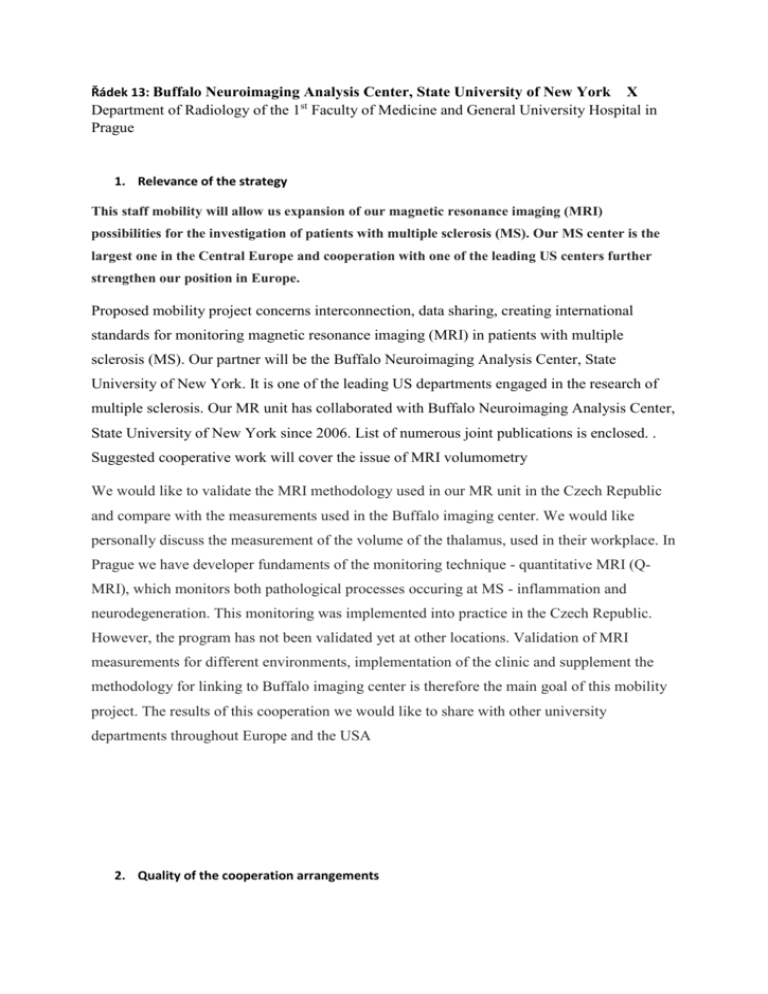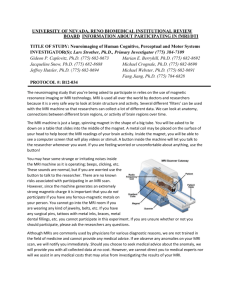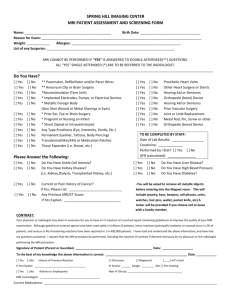Řádek 13: Buffalo Neuroimaging Analysis Center, State University of
advertisement

Řádek 13: Buffalo Neuroimaging Analysis Center, State University of New York X Department of Radiology of the 1 Faculty of Medicine and General University Hospital in Prague st 1. Relevance of the strategy This staff mobility will allow us expansion of our magnetic resonance imaging (MRI) possibilities for the investigation of patients with multiple sclerosis (MS). Our MS center is the largest one in the Central Europe and cooperation with one of the leading US centers further strengthen our position in Europe. Proposed mobility project concerns interconnection, data sharing, creating international standards for monitoring magnetic resonance imaging (MRI) in patients with multiple sclerosis (MS). Our partner will be the Buffalo Neuroimaging Analysis Center, State University of New York. It is one of the leading US departments engaged in the research of multiple sclerosis. Our MR unit has collaborated with Buffalo Neuroimaging Analysis Center, State University of New York since 2006. List of numerous joint publications is enclosed. . Suggested cooperative work will cover the issue of MRI volumometry We would like to validate the MRI methodology used in our MR unit in the Czech Republic and compare with the measurements used in the Buffalo imaging center. We would like personally discuss the measurement of the volume of the thalamus, used in their workplace. In Prague we have developer fundaments of the monitoring technique - quantitative MRI (QMRI), which monitors both pathological processes occuring at MS - inflammation and neurodegeneration. This monitoring was implemented into practice in the Czech Republic. However, the program has not been validated yet at other locations. Validation of MRI measurements for different environments, implementation of the clinic and supplement the methodology for linking to Buffalo imaging center is therefore the main goal of this mobility project. The results of this cooperation we would like to share with other university departments throughout Europe and the USA 2. Quality of the cooperation arrangements Charles University in Prague, First Faculty of Medicine, Department of Radiology, MR unit, has collaborated with Buffalo Neuroimaging Analysis Center, State University of New York since 2006. Quality of collaboration directly follows from this joint publication list; Horakova D, Dwyer MG, Havrdova E, Cox JL, Dolezal O, Bergsland N, Rimes B, Seidl Z, Vaneckova M, Zivadinov R. Gray matter atrophy and disability progression in patients with early relapsing-g multiple sclerosis. A 5-year longitudinal study. J Neurol Sci. 2009 Jul 15;282(1-2):112-9. Bergsland N, Horakova D, Dwyer MG, Dolezal O, Seidl Z, Vaneckova M, Krasensky J, Havrdova E, Zivadinov R. Subcortical and cortical gray matter atrophy in a large sample of patients with clinically isolated syndrome and early relapsing-remitting multiple sclerosis. AJNR Am J Neuroradiol. 2012 Sep;33(8):1573-8 (IF 3,167) Zivadinov R, Havrdova E, Bergsland N, Tyblova M, Hagemeire J, Seidl Z, Dwyer MG, Vaneckova M, Krasensky J, Carl E, Kalincik T, Horakova D. Thalamic Atrophy Is Associated with Development of Clinical Definite Multiple Sclerosis. Radiology 2013 2013 Sep;268(3):831-841. Weinstock-Guttman B, Zivadinov R, Horakova D, Havrdova E, Qu J, Shyh G, Lakota E, O'Connor K, Badgett D, Tamaño-Blanco M, Tyblova M, Hussein S, Bergsland N, Willis L, Krasensky J, Vaneckova M, Seidl Z, Ramanathan M. Lipid profiles are associated with lesion formation over 24 months in interferon-β treated patients following the first demyelinating event. J Neurol Neurosurg Psychiatry. 2013 Apr 17. Browne RW, Weinstock-Guttman B, Horakova D, Zivadinov R, Bodziak ML, Tamaño-Blanco M, Badgett D, Tyblova M, Vaneckova M, Seidl Z, Krasensky J, Bergsland N, Ramasamy DP, Hagemeier J, Havrdova E, Ramanathan M. Apolipoproteins are Associated with New MRI Lesions and Deep Gray Matter Atrophy in Clinically Isolated Syndromes. JNNP 2014, Aug 85(8):859-64. Several colleagues from Department of Neurology in Prague have already worked on the cooperating workplace. It brought to our workplace knowledge which we have also utilized in our research. It brought very close cooperation. This visit of Prof. Manuela Vaneckova should be the first visit from the Radiology department. We collaborated on research regarding the presence of cortical bearings in MS patients. We have shown before the advent of more sophisticated methods for detecting pathologies of the gray matter, the cortex is affected from the beginning of the disease and the number of bearings increases with disease duration. We further found that the cortical bearings better correlate with clinical disability than hypersignal bearings T2 W image. We dealt with in cooperation with the Buffalo with environmental factors related to MS and biochemical markers in RS and their relationship to the bearing disabilities magnetic resonance. We found an increasing evidence that serum lipoprotein cholesterol biomarkers are associated with disease progression in clinically isolated syndromes (CIS). The objective of another study was to investigate whether serum Apo levels are associated with CIS disease progression. 3. Quality of project design and implementation A mutual bilateral cooperation has been already set; we share the data and we both test the evaluating systems. Our common goal is to create the MR monitoring scheme for worldwide use. In collaboration with the State University of New York in Buffalo, NY, USA we will be measuring the central gray matter, we will compare measurements of atrophy of the thalamus, the lateral ventricles and corpus callosum. The aim of this research is to identify the most robust markers and determine whether they are independent of each other and whether their merger will result in even higher predictive power. Multiple sclerosis (MS) is a chronic disorder of the nervous system with highly variable and unpredictable clinical course. We currently have no cure for MS, however, with the help of timely anti-inflammatory therapy we are able to ameliorate its course. Efficacy of the available treatments in individual patients is highly variable. Therefore the exact quantification of disease activity is crucial. For this purpose, the currently available clinical variables (relapses and EDSS) and conventional MRI markers (number of lesions) are of a limited value. Volumetric MRI (global and regional brain atrophy) seems to be better predictor of continuing clinical activity. The aims of the project are: 1) to identify quantitative MRI markers with improved individual descriptive and predictive values 2) to implement quantitative measurement of brain volume change into a real clinical practice Project: Multicenter study will be designed in two phases: the retrospective and prospective one. The retrospective part of the study will use already collected data from 150 MS patients at three different sites (Buffalo, Prague and Sydney). The following MRI measures will be generated: Percentage change in whole brain volume Percentage change in gray matter (GM) volume Percentage change in lateral ventricle volume (LVV) Number of new/enlarging T2 lesions Absolute T2-lesion volume and absolute change in T2-lesion volume The use of different software methods and approaches to the same data set will validate sensitivity and specificity in detecting changes over time. The data will be also assessed by exploring relationship between different software methods and approaches with clinical outcomes. The QMRI and radiological reports will be compared in a blinded manner. In addition, a prospective part of the study will include 150 MS patients at three different sites (Buffalo, Prague and Sydney). The inclusion criteria for that part of the study will be: Being relapsing-remitting (RR=25) or secondary-progressive (SP=25) MS patient at each site Having baseline MRI scan acquired using standardized MRI protocol at 1.5T or 3T in which there is a presence of high resolution 3D-T1 and 2D or 3D FLAIR sequence Obtaining a follow-up MRI standardized MRI scan at the same scanner in real time separated at least one or more years apart from the baseline scan Having Expanded Disability Status Scale (EDSS) assessment at baseline and at followup Not having steroid treatment or relapse 30 days prior to the MRI scan at baseline or follow-up Having radiological examination by a certified MRI reader Obtaining a clinical questionnaire in which the treating/examining neurologist evaluates usefulness of QMRI report in real time for individual MS patient decision making. In particular the questionnaire will focus on: establishing or ruling out a diagnosis of MS; starting or changing DMT; determining prognosis; establishing which quantitative MRI metric is the most helpful in clinical decision making; and comparing the information with radiological qualitative MRI evaluation alone. At each site the scans will be analyzed by the local imaging center and by the icoMetrix centrally. Correlation between the icoMetrix measures and the local image analysis reports (for all atrophy and lesion measures): a Pearson correlation analysis as well as measurement of the intra-class correlation coefficient (ICC) A logistic regression analysis will be performed to evaluate the role of the different MRI measures in predicting clinical changes. From the radiological reports, a % of reports will be calculated that contains quantitative information on either brain atrophy and/or lesion count and changes. For the reports that contain quantitative information, a regression analysis will be used to correlate these outcomes with the MRI measures derived by image analysis. For the prospective analyses, a similar comparison between the methods as well as correlation with clinical outcome will be performed. In addition, a clinical questionnaire will be created for every patient by the local treating clinician. Based on these questionnaires, the value and clinical utility of the different MRI reports will be compared and they will be used to further improve the use of quantitative MRI information and QMRI reports in clinical practice. 4. Impact and dissemination The project seeks to spread technique of the MR volumometry to university facilities all over the world. The project should help us extend our results outside the Czech Republic, in the Europe, where we are one of the main centers dealing with volumometry in MS patients. The project is of great practical impact, because it shows that MR is the main biomarker that helps to find appropriate treatment for an individual patient with MS. The predictive ability of MR shows how the disease irreversibly proceeds; it would be timely to elect adequate treatment. The goal of project is to evaluate the use QMRI report and establish its value, as a new standardized instrument for assessment of disease activity and clinical progression on a routine basis for individual patients with MS. Among the MRI measures, part of the QMRI report, we will evaluate change in global and tissue specific brain atrophy measures, accumulation of new/enlarging lesions and progression of lesion volume in clinical decision making. The project aims first to compare the measurement techniques on both sites, with the aim to find the most robust marker in terms of long-term predictions of disease progression. Check whether the methodology developed for MR unit is also applicable to other academic work. Whether the transmission system and data sharing between radiological and clinical workplaces (MS Center, Neurological Clinic) is user-friendly enough to quicken and especially improve the quality of care for patients with MS. MR monitoring could then become a leading parameter for the treatment algorithm MS patients. MR importance in the last few years has increased significantly since they were introduced in practice the new therapeutic drugs.






